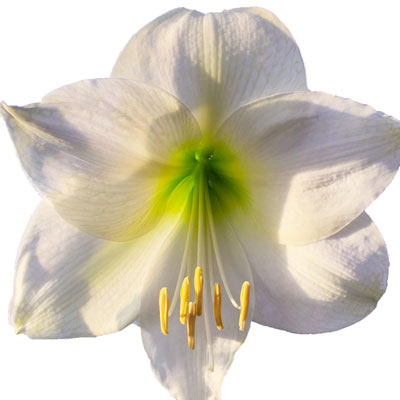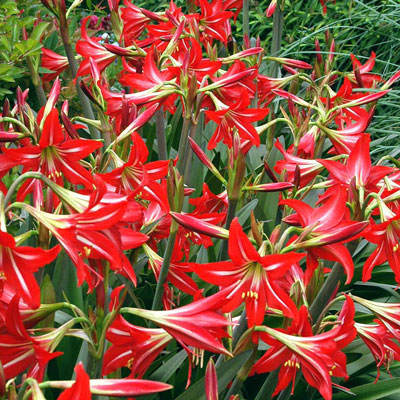Amaryllis Abound

Christmas amaryllis come in shades of red, pink, orange, salmon and pure snowy white.
There are stacks of boxed amaryllis bulbs alongside checkout counters all across Texas right now. Not just in nurseries, but in groceries and hardware stores. I even saw them in a big store selling sheets and towels and beyond.

Photo: This is a second year of blooming for this tropical amaryllis. I forced it into flower for Christmas one year, but the following year (this past spring), it came into bloom in my greenhouse in March.
Whether you give or receive an amaryllis bulb this December, you’ll need to know a little more about this beautiful bulb.
There is confusion between the amaryllis you buy in a pot or a box this time of year and the one you’re given by your friend or neighbor out of their yard.
• Christmas amaryllis are tropical plants out of the Caribbean countries and South America. Their flowers are broad trumpets whose petals and sepals overlap to form a solid vase. They’re winter-hardy in South Texas, but they’ll freeze farther north. Their colors range from white to pink, salmon, orange and red.

Photo: St. Joseph lily, also called “hardy amaryllis,” is the “hardy” cousin of Christmas amaryllis. You can see its more tubular form with narrow petals. We’ll have more details on growing it in the spring.
• “Hardy” amaryllis are more properly called St. Joseph’s lilies. They bloom in the spring, and they can survive temperatures into the teens. Their flowers are also trumpet-shaped, but their petals and sepals are thinner and do not overlap, nor do they recurve. They are predominantly red.
We’ll save the St. Joseph’s lily for a spring discussion. Here are your tips for handling Christmas amaryllis and growing them once they finish blooming.
• Buy first-quality bulbs that have been cared for since they arrived (kept cool and dry). If the boxes are crumpled or if it looks like they’re been wet, move on. And just to have said it, yes they’re expensive. This is not the place to “go cheap.” Buy for quality and you’ll have far better results.
• Most amaryllis come pre-potted with good potting soil. If yours isn’t potted, use a terra cotta pot (for ballast) and a loose, highly organic potting mix. One-third of the bulb should extend out of the soil. Water the soil thoroughly as soon as you take the pot out of the box or plant the bulb in its new pot.
• Amaryllis flowers and foliage will develop most normally if they develop in cool, sunny locations. If you’re growing yours near a window, turn it one-quarter turn every day to keep it from bending.
• No fertilizer will be needed as it comes into bloom. Keep it uniformly moist (but not wet) and away from hot drafts.
• As it finishes blooming, trim the flower stalk off down into the foliage. The leaves will develop as winter turns into spring. They’re actually quite pretty, and they’re critical to its success and reblooming in following winters.
• Use a high-nitrogen, water-soluble fertilizer to feed your amaryllis plant spring through late summer. It will be manufacturing sugars in its foliage, and they will be stored in its bulb as it forms next year’s flower buds in the fall.
• Around the second half of August, lay the plant and its pot on its side and let it go dry for five or six weeks. That will simulate the dry spells it has in its native home.
• By early October you can trim off the dead foliage. Lift the bulb out of its old pot and carefully repot it into fresh potting soil. Water it deeply, and start the whole process over again. Veteran growers tell me they are successful 75 or 80 percent of the time.
